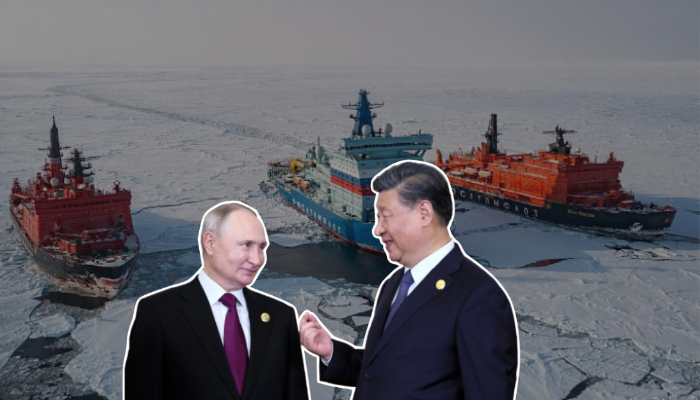Russia and China sign Northern Sea Route deal: Millions of tons of Chinese cargo to be carried across the Arctic Ocean with nuclear ice-breakers. Read why it is significant
On 14th October, the “Russian-Chinese Commission for the Preparation of Regular Meetings of Heads of Government” convened its second meeting of the “Sub-Commission for Cooperation on the Northern Sea Route (NSR)” in Harbin of People’s Republic of China. The action plan for the expansion of shipping between the two countries via the Northern Sea Route was accepted after the meeting. The goal of the roadmap’s development and approval was to create a sustainable transit corridor. The collaboration entails the application of innovative technology and logistics to boost capital projects and shipment efficiency. Russia and China sign Northern Sea Route COOPERATION dealRussia's nuclear agency Rosatom and the Chinese government will implement new technologies and develop joint projects to form a sustainable trade route between the countries pic.twitter.com/u9cX1vXYrw— RT (@RT_com) October 14, 2025 Alexey Likhachev, Director General of Rosatom State Corporation who participated in the crucial event stated, “Russia sees the Northern Sea Route as a key transport artery of the 21st century, capable of providing faster, more efficient and safer connections between continents.” Rosatom, Russia’s State Atomic Energy Corporation, is the organisation that runs 8 massive nuclear-powered icebreakers, the only ones of their kind in the world, through the Arctic Ocean’s frozen territories. Russia has over 40 icebreakers working in the Arctic. 4 more nuclear-powered ones are under construction. Russia operates world’s LARGEST and most ADVANCED fleet of icebreakers, totaling over 408 are nuclear-powered giants, with 4 more under construction Fleet is bigger than that of all NATO countries combined pic.twitter.com/ongqnJGZjG— RT (@RT_com) August 29, 2025 “I am confident that the decisions taken today will give additional impetus to the development of Russian-Chinese cooperation in developing the potential of the Northern Sea Route and will allow us to materialise opportunities for cooperation in major capital projects. Our cooperation allows us not only to diversify global trade routes, but also to introduce advanced technologies in the development of high latitude areas with specific conditions,” he further mentioned. Interestingly, global warming has made it possible for ships to travel the new route which passes through Arctic waters and inside Russia’s exclusive economic zone. A landmark development in shipping operations The Northern Sea Route is the primary maritime route in the Russian part of the Arctic Ocean and is a historically significant national transportation corridor. It extends throughout the Barents, Kara, Laptev, East Siberian, Chukchi, and Bering seas as well as the northern Russian shoreline. It unifies Siberia’s navigable rivers and ports in the Far East Russia alongside Europe into a single transportation network It is the shortest shipping course connecting the western portion of Eurasia with the Asia-Pacific area. The route is roughly 5,600 kilometres long linking Providence Bay and the Kara Strait. With about 37.9 million tonnes of cargo handled in 2024, it set another record surpassing the previous year’s benchmark by over 1.6 million tonnes. Notably, transportation of containers between China and Russia is increasing in volume. The summer-autumn navigation season of 2024 witnessed 14 international container journeys between the ports of northwest Russia and ports of China. This is double the number from 2023. Out of the 22 container journeys scheduled for this year, 17 have already been completed since the start of 2025 and 280,000 tonnes of container cargo have been moved, setting a new milestone. This represents an almost 59% increase over the 176,000 tonnes of freight transported over the entire previous year. Image via Sky News The partners now want to boost Northern Sea Route freight volume to 20 million tonnes by 2030. “We haven’t just set each other the goal of bringing (freight traffic) volumes to 20 million tons by 2030, our roadmap details various areas (of cooperation),” Likhachev highlighted. “It involves implementing modern logistics and technological solutions to increase shipping efficiency and support the development of major projects,” he mentioned. “The cooperation between Russia and China in the coming years will affect not only seafaring and navigation, but also the creation of Arctic-class cargo ships, personnel training, as well as other areas,” the chief executive officer added. Russia and China hope to surpass 400,000 tonnes of containers, achieving a new record for container transportation through the Northern Sea Route. The two nations decided to form a panel devoted to the development of the route earlier last year and the charge was handed over to Chinese Minister of Transportation and Rosatom. The subcommittee intends to transit 50 million tonnes of cargo annually along the pathway. A polar silk route: Why is the NSR imp



On 14th October, the “Russian-Chinese Commission for the Preparation of Regular Meetings of Heads of Government” convened its second meeting of the “Sub-Commission for Cooperation on the Northern Sea Route (NSR)” in Harbin of People’s Republic of China. The action plan for the expansion of shipping between the two countries via the Northern Sea Route was accepted after the meeting.
The goal of the roadmap’s development and approval was to create a sustainable transit corridor. The collaboration entails the application of innovative technology and logistics to boost capital projects and shipment efficiency.









































































